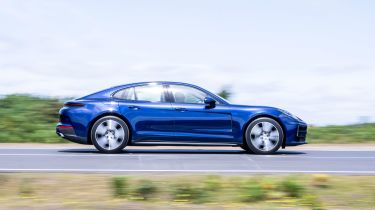Porsche Panamera review - MPG, running costs & CO2
The Porsche Panamera was never designed to sip fuel and offer low bills, but the hybrid models are impressively economical
A decade or two ago, if you wanted a fast car (one that went from 0-62mph in five seconds or so) you could reasonably expect to be taxed very heavily for it, and have to refuel it frequently enough to make several stops on long journeys. Fuel consumption figures in the mid-to-low teens were not unheard of and some cars had a very short range if driven hard.
Technology prevails, especially in the case of the E-Hybrid models, which use electric power to give the petrol motor a helping hand or propel the Panamera for up to 60 miles on electricity alone, dramatically reducing running costs. You’ll need to plug it in regularly if you want to benefit from that lofty fuel economy figure, however.
Porsche Panamera MPG & CO2
The least expensive version to buy is the standard petrol-only Panamera. It uses a 2.9-litre turbocharged engine and can return up to 29.1mpg, depending on specification, with CO2 emissions from 219g/km. Specifying four-wheel drive with the Panamera 4 drops this fuel economy figure down slightly to 27.7mpg. CO2 emissions also increase to 230g/km ruling it out for company car drivers, while making entry versions the top pick for private buyers who want the Panamera experience, but don’t need the last word in performance.
More reviews
The Panamera GTS arrived later with even more impressive performance – that does come at the cost of fuel-efficiency, though and its twin-turbocharged V8 engine means it returns just 23.5mpg and emits 274g/km of CO2.
The most fuel-efficient Porsche Panameras according to official figures are unsurprisingly the E-Hybrid plug-in models. The 4 E-Hybrid model returns up to 282.5mpg with very low CO2 emissions from 22g/km. Be warned, though, that if you fail to keep the battery topped up, fuel economy will suffer greatly, so it’s best to make sure you have a reliable way of keeping it charged if you want to achieve such impressive figures.
While both the 4 E-Hybrid and 4S E-Hybrid boast up to 58 miles of electric range, the increased power output from the 4S E-Hybrid’s combustion engine means fuel economy suffers, but these models still have official figures well above 200mpg.
The top-spec Porsche Panamera Turbo E-Hybrid and Turbo S E-Hybrid are the least economical of the plug-in hybrids, but even these are still capable of around 200mpg in the right spec, while producing just over 30g/km of CO2 and managing just over 50 miles of EV range.
Such low official emissions figures make the plug-in hybrids the best choice for company-car buyers, as they sit in low Benefit-in-Kind (BiK) groups. In addition, hybrids are eligible for a £10 discount on VED road tax as they are classed as alternative-fuel vehicles. Any Porsche Panamera will incur the annual luxury car tax surcharge in the first five years of ownership, given all models cost over £40,000.
Servicing
It’ll be impossible to run a Panamera on a tight budget, but Porsche offers fixed-price servicing to make planning maintenance easier. A minor service for the previous Panamera costs about £450 from a Porsche dealership, while a major is more like £550; brake fluid replacement comes in at £150 alone.
Warranty
Porsche’s standard three-year/unlimited-mileage warranty applies here. This is unexceptional in terms of duration, though the lack of a mileage cap is welcome. It also includes Porsche Assistance breakdown cover that is valid anywhere in Europe.
Insurance
Given the Porsche Panamera is a relatively expensive and high-end car, insurance group ratings are likely to be high, although specific groups are yet to be confirmed for the latest facelift. The outgoing entry-level petrol Panamera sat in group 46, and it wasn’t hard to move up the range to hit the maximum group 50 rating, either – pre-facelift cars from 4S E-Hybrid upwards all sit in that bracket.











